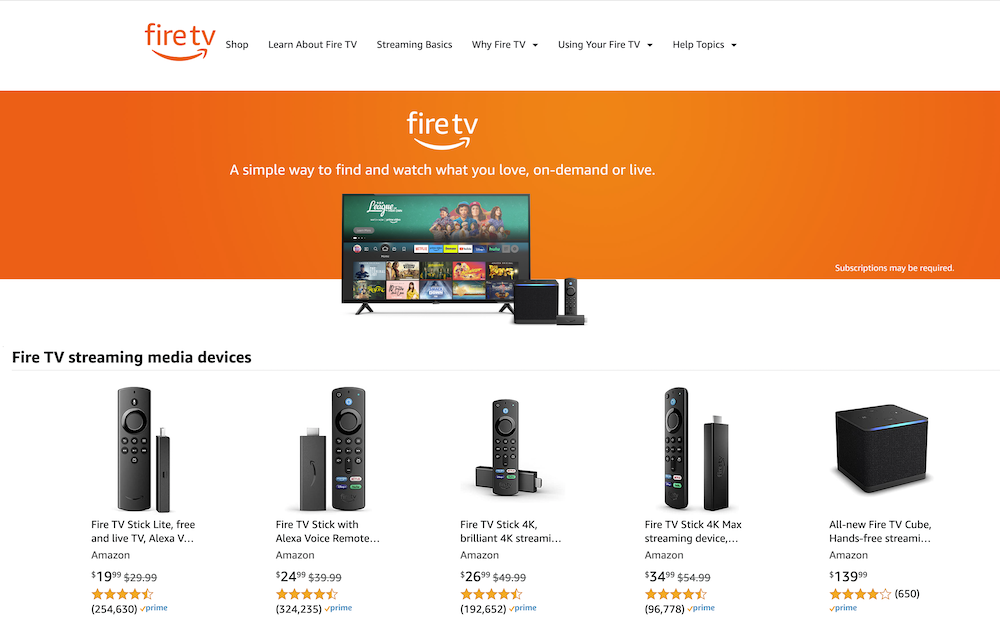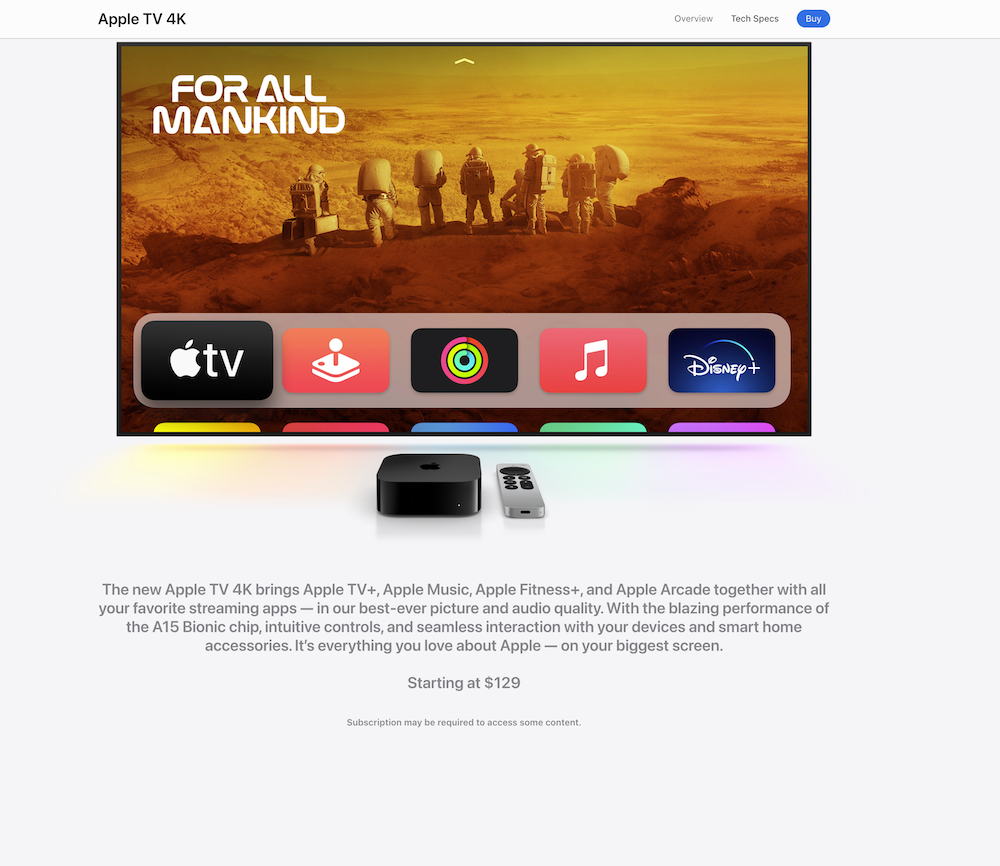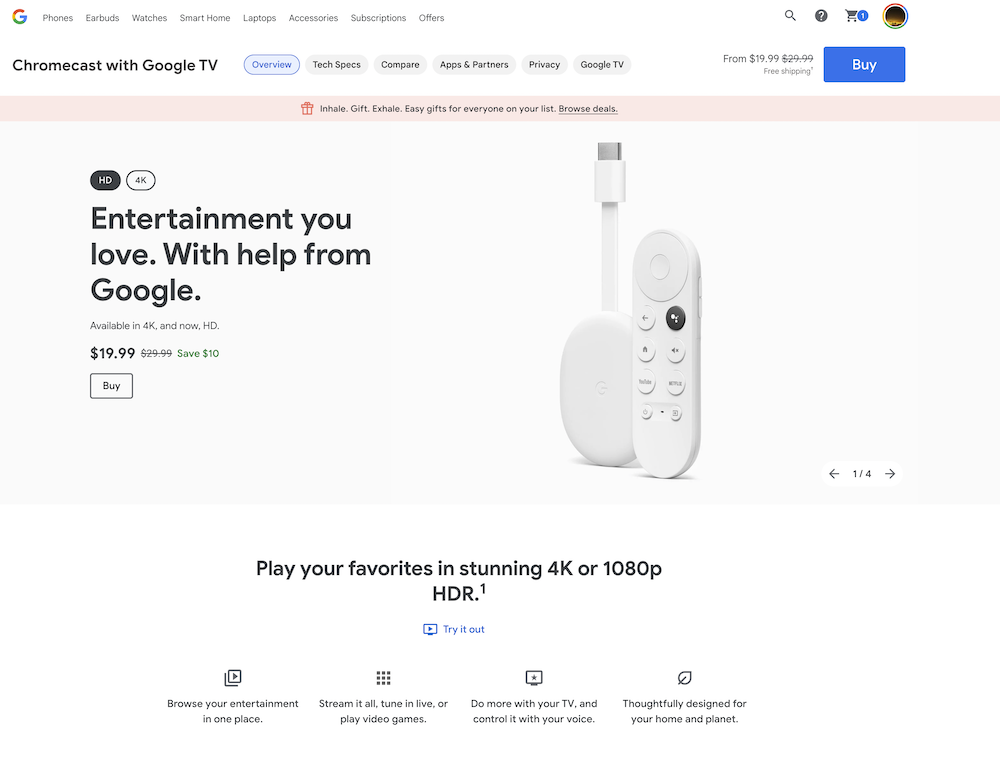If you’re looking to add smart capabilities to an existing TV, you’ve got lots of options, including Roku, Apple TV, Chromecast with Google TV, and Amazon Fire TV. What are the differences, and what’s best for you? Find out now in this guide from Flixed, as we compare Roku vs. Apple TV vs. Amazon Fire vs. Chromecast with Google TV.
Roku

Roku was first founded way back in 2008. Since they were founded, they’ve become one of the biggest players in streaming media, with a market share estimated by CNBC at about 36% of all streaming media players and smart TVs as of 2021. But what sets Roku apart from the competition? Read on and find out.
Audio and visual streaming quality
Depending on the Roku device you choose, you’ll get either 1080p HD or 4K support. The Roku Express only supports 1080p, which is fine if you don’t have a 4K TV, and you’re looking for a budget option.
The Roku Express 4K+ supports 4K and HDR, but lacks support for Dolby Vision HDR technology – for that, you’ll need the Roku Streaming Stick 4K, Roku Streaming Stick 4K+, or Roku Ultra.
As far as audio quality goes, you won’t be disappointed. Every Roku device supports either DTS or Dolby Atmos for up to 7.1 surround sound, so you can enjoy a truly cinematic experience in the comfort of your own home.
Remote control
Depending on the Roku device you buy, you’ll get either a basic remote or the Voice Remote Pro. The basic remote does pretty much what you’d expect. You can easily navigate your Roku, play content, and use shortcuts to access popular streamers like Netflix and Disney+.
The Voice Remote Pro has some added features. It has voice controls, so you can just say “Play Game Of Thrones” instead of navigating to HBO Max. It also has a lost remote finding feature, customizable shortcut buttons, and even a 3.5mm headphone jack that you can use to listen to your Roku with headphones, which is a nice feature.
You can also download the Roku app on your phone to control your Roku directly from your iOS or Android device. This works fine, but the normal remote control offers a better experience for pretty much everything except text entry.
Design and user experience
Overall, Roku has one of the best user interface (UI) designs of any streaming player. All of your content is available in one place, and it’s easy to navigate between streaming apps or “Channels” as they're called by Roku.
The channel store has plenty of apps for all of the best streaming services like Netflix, Hulu, and Amazon Prime Video, so you can watch all your favorite streamers in one place. Uniquely, Roku also has some free channels and original shows, like Weird: The Al Yankovic Story and Dummy, starring Anna Kendrick. You can watch all of these shows simply by buying a Roku device – they're 100% free.
What’s Roku best for?
Roku is the best for any cord-cutter who isn’t tied into any particular tech ecosystem like Apple, Amazon, or Google, and just wants a simple, all-purpose streaming device that will work seamlessly with top streaming services – and offers free content and channels, to boot.
But which device should you get? If you want a Roku, we recommend the Roku Streaming Stick 4K. It’s affordable, but still has all the latest bells and whistles you need for the best streaming experience.
Amazon Fire TV

Amazon got into the streaming device game back in 2014 with the launch of the original Amazon Fire TV Stick, and they’ve quickly become one of the top players in the industry. Like Roku, Amazon Fire TV devices are estimated to have a market share of about 36% as of the most recently available data.
Audio and visual streaming quality
Overall, you’ll get great video and audio quality with any Amazon Fire Stick or Fire TV streaming device. As the cheapest Amazon Fire TV devices, the Amazon Fire TV Stick and Amazon Fire TV Stick Lite both only offer 1080p streaming, and lack HDR support.
To get HDR and 4K, you’ll need the Amazon Fire TV Stick 4K, Fire TV Stick 4K Max, or Fire TV Cube. Every Amazon Fire TV product except the Fire TV Stick Lite also supports Dolby Atmos for surround-sound capabilities.
Remote control
The basic Amazon Fire TV remote is fine. It has all the basic controls you’d expect for controlling playback and accessing your streaming apps. It also has Alexa support for searching for content, though you can’t control playback by voice with the basic remote.
For that, you’ll need the Alexa Voice Remote Pro. This remote allows you to control volume and playback with Alexa, and it also has customizable shortcuts, backlit buttons, and a “lost remote” feature to help you find your missing remote.
Amazon Fire TV also lets you download their app and use it to control your TV. Again, this is nice for entering text like your email address or passwords for streaming services, or if you’ve lost your remote, but in general, it’s more convenient to rely on the dedicated remote that comes with your device.
Design and user experience
Amazon Fire TV has a decent UI and user experience. All of their latest devices come with at least 8GB of storage and 1GB of RAM for a smooth playback and navigation experience.
The main thing that you’ll notice, though, is that you’ll see a lot of ads and promotions for Amazon’s shows and other Prime features like Prime Photos and Prime Music. If you’re not an Amazon Prime subscriber, these can get tiresome.
If you are a Prime member, though, the tight integrations with Amazon are a good thing. It’s easy to use Prime Video and access your other Prime benefits directly from your TV.
What’s Amazon Fire TV best for?
Amazon Fire TV is the best for anyone who makes extensive use of Amazon Prime and Amazon Prime Video. These devices are affordable and fairly powerful, and integrate well into Amazon’s overall ecosystem.
But which one is right for you? If you’re buying a new Amazon Fire TV Stick, we recommend going for the Fire TV Stick 4K Max. It has the best features including 4K and HDR support, WiFi 6 support, and even additional RAM and a more powerful processor for a smoother viewing experience, all at a reasonable price.
Apple TV

The first Apple TV was introduced way back in 2007, though these devices did not become common until 2010, with the release of their second generation of Apple TV devices. While Apple TV doesn’t have the same market share as Roku or Amazon Fire TV, it’s still a great premium option for Apple enthusiasts.
Audio and visual streaming quality
With the release of the Apple TV 4K in October, Apple quietly discontinued the Apple TV HD, which had been around since 2015. There may still be some Apple TV HD devices in stock, but if you’re looking for a new Apple TV, 4K is your only option.
The new Apple TV 4K is powered by Apple’s A15 Bionic chip, which means that it offers excellent overall streaming performance and smooth navigation, and it also supports HDR10+ as well as Dolby Vision for stunning HDR performance on HDR-enabled TVs.
It also supports Dolby Atmos and surround sound for home theater systems, so you’ll enjoy an exceptional audio experience while watching your favorite shows and movies.
Remote control
All new Apple TV 4K devices come with the upgraded Siri Remote. This replaces the old Apple TV remote and improves upon it in many ways. This includes a thicker design that’s harder to lose, easier access to the Siri voice assistant, and the replacement of the previous remote’s touchpad with a d-pad.
As you’d expect from Apple, this remote is also machined from a solid block of aluminum, so it feels thick and durable, and truly premium, especially when compared to remotes from the competition.
Like its competitors, Apple also offers an app you can download onto both iPhone and Android to control your Apple TV. This is fine in a pinch and for entering text, but it’s not the most convenient way to control your device.
Design and user experience
The Apple TV 4K has a streamlined user interface that integrates tightly with Apple TV+, Apple Music, iCloud and other apps and smart home devices from Apple, so it’s a great option if you’re heavily tied into iOS, macOS, and the general Apple ecosystem.
Compared to the competition, the Apple TV 4K has more horsepower under the hood, and boasts either 64GB or 128GB of storage, a powerful processor, and 4GB of RAM. That adds up to a very smooth navigation and playback experience that’s free of stuttering and long loading times.
Of course, it also supports most major streaming services, including Netflix, Hulu, Amazon Prime Video, and every other service you can think of. Watching your favorite content is a breeze with Apple TV’s great streamer support.
What’s Apple TV best for?
Apple TV is the best for people who are heavily into the Apple ecosystem, or who want a truly premium TV experience that’s 100% free of lag, stuttering, and other issues. It’s also a great option for gamers. With Apple TV, you can install most iOS games directly on your device, play them with a connected Bluetooth controller, and get great performance thanks to its heavy-duty processor.
However, it’s expensive. Unless you’re truly going to make use of its power and features, you can get away with buying a Roku or similar device for about a quarter of the price of a brand-new Apple TV 4K – and you’ll still get a pretty similar overall experience. Still, if you’re interested in a truly premium experience, you can take a look at the Apple TV 4K here, and see if it’s right for you.
Chromecast With Google TV

Chromecast was first launched in 2013. At first, this little dongle simply allowed you connect your smartphone to any TV and “Cast” digital content. But over time, it’s evolved – and today, Chromecast with Google TV maintains Google’s “Cast” feature, while also turning your TV into a fully-functional smart TV, powered by Android TV.
Audio and visual streaming quality
As the name implies, the cheaper Chromecast With Google TV HD Version only supports 1080p, but it does boast HDR support. For 4K support, you’ll need the slightly more expensive Chromecast With Google TV 4K Version. Both versions of the Chromecast with Google TV support Dolby Atmos, too, so you can get full 5.1 or 7.1 surround sound if your streaming content supports it.
Remote control
In the past, Chromecast didn’t have a remote control, and you controlled it from your phone. But the new Chromecast With Google TV has introduced a remote, so this makes it much more similar to the competition like Roku and Amazon Fire TV.
The remote is basic, but gets the job done, with simple navigation, power, and playback controls, as well as integration with Google Assistant for hands-free navigation and playback controls.
Like its competitors, Chromecast With Google TV lets you control it with the Google TV app. This is good for entering text or if you’ve lost your remote, but you’ll want to use the included remote for general TV viewing.
Design and user experience
Chromecast with Google TV has a good overall user experience, and is quite comparable to Roku or Amazon Fire TV. You can download tons of apps and streaming services directly from the Google Play Store, so it has fantastic support for most streamers.
There also aren’t too many ads, unlike some competitors like Roku. The best feature of Chromecast with Google TV, though, is the Cast functionality. Cast lets you “throw” your screen from any Android, iOS, Windows, or macOS device onto your TV. This feature is a bit niche at this point, but if you want to share screens from other devices on your TV, Google Cast is the fastest and simplest way to do so.
What’s Chromecast With Google TV best for?
Chromecast With Google TV is the best option for people who like Google and Android, and will regularly use their TV for “casting” content from other devices. However, it’s a bit more complicated and harder to set up compared to Amazon Fire TV and Roku, so it’s not the best if you’re not tech-savvy.
Which Chromecast With Google TV should you get? We recommend the Chromecast With Google TV 4K Version. It has support for 4K, unlike its cheaper counterpart, so this will help “future proof” your home streaming setup, even if you don’t currently have a 4K TV.
Our pick: The Roku Streaming Stick 4K is the best for most people
Thanks for reading our comparison. If you’re still not sure which device to choose, we’ll make things simple! We recently named the Roku Streaming Stick 4K as our favorite overall streaming device – and that’s still our recommendation at Flixed.
If you don’t already have a smart TV or a streaming device, the Roku Streaming Stick 4K combines the best user interface, simple setup, plenty of power, and great video and audio features. Check it out on Amazon here, and start streaming right away.
Eric Liston
Eric Liston is a content writer based in Columbus, Ohio. Since 2015, he’s been writing about technology, cord-cutting, and helping everyday people save money. He also has expertise writing about medicine, dentistry, insurance, and a variety of other industries. No matter what he’s writing, his focus is always on simplifying complex concepts and making them approachable for everyone. When he’s not slamming away on his keyboard at his home office, you’ll find Eric reading sci-fi novels, improving his disc golf game (he just hit his first 400-foot drive) and playing video games on his gaming PC.

